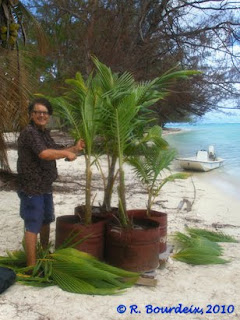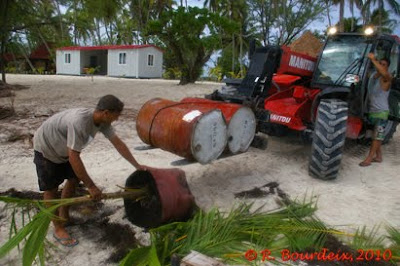Polymotu concept is to use geographical and reproductive isolation to conserve and reproduce varieties of plants and trees. When a small isolated place is planted all with the same variety, the plants conserved there breed only within the same variety, and certified seed and seednuts can be produced at the lower cost. These isolated places can be small islands or small valleys; they can also be located in flat mainland, with landscaping designed to create pollen barriers.
There is, at least, one modern example of an island which was recently devoted to the conservation and use of a unique coconut variety,. This is a great success story, because it is a profitable business and it could also lead to a major improvement of this coconut variety. Click on the pictures to enlarge them.
Makapuno is an economically important coconut variety. Instead of coconut water, this coconut contains a soft, white jelly-like mass which is considered a delicacy. Makapuno is preserved in heavy sugar syrup and bottled for local consumption and export. In the Philippines alone, the domestic market needs 4 million kg of the highly-priced Makapuno meat annually. Less than 3% of that demand is being met. Makapuno coconuts are sold for at least 5 times the price of an ordinary coconut.

Growing Makapuno is unlike growing ordinary coconut trees. In each coconut bunch produced by such a palm, 15 to 20 % of the fruits only are Makapuno, the remaining are normal coconuts. Makapuno coconuts do not germinate because the abnormal jelly-like kernel does not support the growth and development of the embryo (Mujer et al., 1984). So the only way to reproduce a Makapuno coconut was to germinate a normal coconut from a Makapuno palm ; and not all these germinated coconuts will give Makapuno palms.

The coconut embryo culture technology was developed in the Philippines in the 1960s. Using in vitro culture, Dr. Emerita de Guzman rescued the first embryo from a non-germinating Makapuno coconut. Dr. Erlinda P. Rillo and her team did further research and exploited this technique to develop a Makapuno-based industry in the Philippines (Rillo & Paloma, 1992 ; Areza-Ubaldo & al., 2003).oo
The opportunity to create a Makapuno Island in Thailand was seized 25 years ago, when the Thai government built the huge Srinakharin dam at Kanchanaburi. The hills were submerged and their peaks turned into more than 100 islands. All the coconut trees in one island were destroyed. Then the island was planted with Makapuno embryos rescued by using in vitro culture. In order to get a large amount of embryos, the Makapuno seednuts were collected from whole Thailand. Researchers paid 50 Bath for each Makapuno nut. Then, they split the nuts, took the embryos, and sell the remaining half Makapuno nuts each at 50 Bath in the Bangkok markets (
Thai way, never miss a business). Not all the collected Makapuno nuts were the big round fruits typical from the Thailand tall varieties. A few dwarf palms were producing
 |
| On the way to Makapuno Island |
Makapuno coconuts not typical to the Thailand Tall. About 20000 coconuts were bought. 8000 good embryos were obtained and cultivated in vitro. 2000 plantlets were obtained, then transferred and planted in the Island.
The island is located near the Burmese border, at about 200 km North-West from Bangkok (Latitude: 14°54'32.34"N; longitude: 98°31'29.40"E). No stray coconut pollen can reach the island of the because of the distance across the water barrier and pf absence of coconut palm on the closest land. All the marketing of the island was based on the fact that its coconuts never germinate, because they are 100 percent Makapuno.
 |
| Makapuno Palms |
 |
| Departure to Makapuno Island |
On the 25th November 2009, Thanks to Thai researchers and the Department of Agriculture of Thailand, we had the great opportunity to visit the Pathi or Makapuno Island. It takes about 20 minutes to reach the island using a small boat.
When arriving, the island looks like any nice traditional Thai coconut plantation, except for one detail: no forgotten germinated seednuts are growing on the ground. Many fruit species are growing there. Some of the coconut palms are heavy producers; the average production seems to be 80 to 100 coconuts per palm per year. Nobody can imagine that these coconut palms were grown in glass tubes.
 |
| One of the best Makapuno palms |
Dr Narong Chomchalow, President of the Thailand Network for the Conservation and Enhancement of Landraces of Cultivated Plants (TNCEL), gave us the following information about Makapuno in Thailand: "There are two main types of Makapuno in Thailand. One is called Kathi Khao Chao (non-glutinous) - the meat is rather hard, borne on the fruit which is not fully mature or those newly harvested fruits. If the palm is planted on fertile land, the fruit has thicker meat than when the palm is planted in infertile land. Its general characteristics are as follow: light (non-viscous) water, thin meat, rather hard and not as fluffy as the other type (see later); it is used in food processing such as boiled in syrup, blend, or make into ice cream.oo The second type is called Kathi Khao Niao (glutinous) - derived from fruits which are picked when fully mature, i.e. remaining on the tree for a longer period, or has been stored for a long time before opening. Its general characteristics are as follow: viscous water, thick meat, soft and more fluffy than Kathi Khao Chao.oo It is popularly consumed fresh. If the fruit is kept for a longer period, the meat disintegrates with rancid odor. Sometimes all the meat disappeared.
 |
Dr Narong Chomchalow, Dr.Uthai Charanasri and a worker
|
 |
| Kathi Khao Niao (glutinous) |
This is known as dumb coconut or Duean Kin (meaning Moon Eats), probably the same as those which are called eaten by the devil or eaten by the moon in other countries."
It seems that it exists a type of Makapuno in the Philippines that does not exist in Thailand. This type is called ‘Type 3’ by the Filipinos; when the fruit is 10-11 month old, the cavity of the nut is already almost fully filled with meat. In Makapuno island in Thailand, we observed an overmature fruit with the cavity almost filled with meat, but this is not the same. In Thailand, it occurs only for overmature fruits while in the Philippines, this can be encountered on younger fruits.
Another island on the same lake was designed for producing oil palm seeds. As this island is completely isolated from any other pollen source, there is no need to bag the inflorescences for producing seedlings. This generates subsequent economy of manpower. We made the observation that producing of both Makapuno coconut and Oil palm seeds production could be conducted on the same island.
 |
| Kathi Khao Chao (non-glutinous) |
A few years back, the Makapuno Island Company received a complaint from one of their customers that one of their 100-percent guaranteed Makapuno fruits germinated. The owner investigated and upon opening the fruit, it turned out to be Makapuno. As the evolutionary process is continually unfolding, one individual Makapuno was somehow able to develop enzymes to digest and metabolize the endosperm, thereby enabling germination. This began a search for the mother tree that bore this very unusual and attractive germinating Makapuno fruit. This palm was found and its progeny planted.oo
 |
| Arrival at Makapuno Island |
Dr Somchai Watanayothin, Coconut Breeder at the Horticulture Research Institute of Thailand, added the following information: "During the year 2000, the owner of Makapuno Island in Thong pa-phumi District, found out the mother palm that produced Makapuno fruits germinated. He harvested Makapuno nuts and raised them in the nursery. After three months he have got 5 seedlings but two of them grew up. The other three seedlings dead. He brought two Makapuno seedlings to plant in Palm oil Island, at about 30 minutes of Makapuno by a rapid speed boat. Now they are six years old but they have not yet bared fruits. That is a history of the new strain of germinating Makapuno in Thailand.” Makapuno Island could lead to a great and unexpected improvement of the Makapuno variety.
So, we can assert that the precursor of the Polymotu concept is a Thai researcher; the reason why Drs Somchai Watanayothin and
Uthai Charanasri were searching for geographical and reproductive isolation of palms was more specific than ours; it was linked to the special habit of the Makapuno coconut variety. This was also made on the
Thai way, directly as a profitable business: up to now I am not sure that Thai researchers really realize the huge conservation value of what they did.
Anyway the Polymotu concept can be seen as a generalization of the pioneer work of Drs
Uthai Charanasri, Somchai Watanayothin and Narong Chomchallow.
 |
| Srinakharin lake, at departure from Makapuno Island |
 In June 2009, the company Beachcomber SA and the family of the late actor Marlon Brando gave their agreement to integrate the atoll of Tetiaroa in a project of conservation of coconut varieties from Polynesia.
In June 2009, the company Beachcomber SA and the family of the late actor Marlon Brando gave their agreement to integrate the atoll of Tetiaroa in a project of conservation of coconut varieties from Polynesia. 








